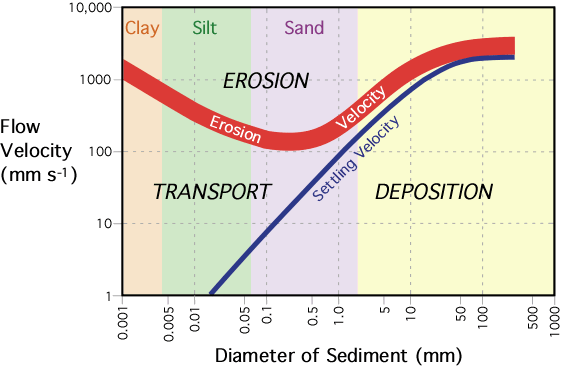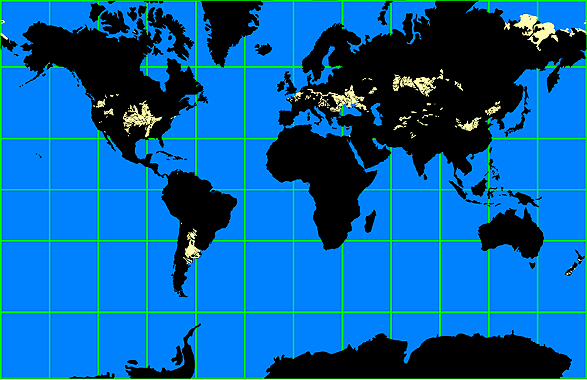|

Figure 10w-2: This graph describes the relationship between
stream flow velocity and particle erosion(浸食), transport(運搬),
and deposition(堆積).
The curved line labeled "erosion velocity"
describes the velocity required to entrain particles from the
stream's bed and banks. The erosion velocity curve is drawn as
a thick line because the erosion particles tends to be influenced
by a variety of factors that changes from stream to stream. Also,
note that the entrainment of silt and clay needs greater velocities
then larger sand particles. This situation occurs because silt
and clay have the ability to form cohesive bounds between particles.
Because of the bonding, greater flow velocities are required
to break the bonds and move these particles. The graph also indicates
that the transport of particles requires lower flow velocities
then erosion. This is especially true of silt and clay particles.
Finally, the line labeled "settling velocity" shows
at what velocity certain sized particles fall out of transport
and are deposited.
〔Okanagan University CollegeのDepartment of GeographyのMichael
Pidwirny氏によるPhysicalGeography.netの『FUNDAMENTALS
OF PHYSICAL GEOGRAPHY』の『CHAPTER
10: Introduction to the Lithosphere』の中の『(w).
Erosion and Deposition』から〕
河川における、流速と堆積物の粒径(Clay=粘土、Silt=シルト、Sand=砂)との関係を示す図であり、Erosionの領域では浸食作用が起こり、Transportの領域では運搬作用が起こり、Depositionの領域では堆積作用が起こることを示す。 |

/Image487.gif)
/Image488.gif)
/Image486.gif)

/Image1709.gif)

/Image2469.gif)
/Image1932.gif)
/Image1933.gif) Wind-derived
quartz in ocean sediments
Wind-derived
quartz in ocean sediments/Image1934.gif)
/Image1935.gif)
/Image1937.gif)
/Image1936.gif)
/Image1938.gif)
/Image1930.gif)
/Image1929.gif)
/Image1927.gif)
/Image1928.gif)
/Image2489.gif)
/Image2490.gif)